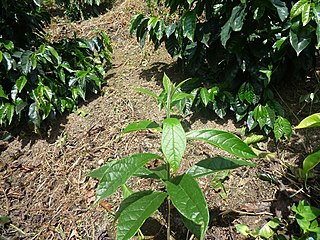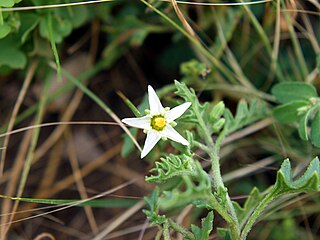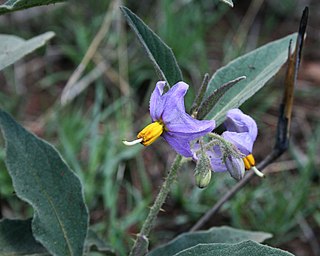
Eggplant, aubergine, brinjal, or baigan is a plant species in the nightshade family Solanaceae. Solanum melongena is grown worldwide for its edible fruit.

Solanum is a large and diverse genus of flowering plants, which include three food crops of high economic importance: the potato, the tomato and the eggplant. It is the largest genus in the nightshade family Solanaceae, comprising around 1,500 species. It also contains the so-called horse nettles, as well as numerous plants cultivated for their ornamental flowers and fruit.

Cordia alliodora is a species of flowering tree in the borage family, Boraginaceae, that is native to the American tropics. It is commonly known as Spanish elm, Ecuador laurel, cypre or salmwood. It can reach 35 m in height.

Michel Félix Dunal was a French botanist. He was a professor of botany in Montpellier, France.

Solanum mauritianum is a small tree or shrub native to South America, including Northern Argentina, Southern Brazil, Paraguay and Uruguay. Its common names include earleaf nightshade, woolly nightshade, flannel weed, bugweed, tobacco weed, tobacco bush, wild tobacco and kerosene plant.

Solanum americanum, commonly known as American black nightshade, small-flowered nightshade or glossy nightshade, is a herbaceous flowering plant of wide though uncertain native range. The certain native range encompasses the tropics and subtropics of the Americas, Melanesia, New Guinea, and Australia.

Solanum nigrum, the European black nightshade or simply black nightshade or blackberry nightshade, is a species of flowering plant in the family Solanaceae, native to Eurasia and introduced in the Americas, Australasia, and South Africa. Ripe berries and cooked leaves of edible strains are used as food in some locales, and plant parts are used as a traditional medicine. Some other species may also be referred to as "black nightshade".

Solanum sarrachoides is a species of South American nightshade known as the hairy nightshade or leafy-fruited nightshade.

Solanum prinophyllum, known as the forest nightshade or Grin Whiskers, is a accepted species of small plant native to the east coast of East Victoria to Southeast Queensland, Australia. S. prinophyllum is a short lived herb, annual or perennial. Forest nightshade grows up to 50 cm high. Its leaves are 5 to 8 cm long and 3 to 5 cm wide. They are spiky and often tinged with purple. The stems are also spiky. Five petalled flowers occur at any time of the year and are blue or lilac in colour. Petals are fused at the base. The fruit is around 15 to 20 mm in diameter and the stem is 10 to 20 mm long. The fruit is a berry, which stays green or turns purple. The habitat is moist areas, in sclerophyll forest, or disturbed areas in rainforest.

Solanum incanum is a species of nightshade, a flowering plant in the family Solanaceae. It is native to East Africa, West Africa, the Middle East, and eastwards to India. The species was introduced to Taiwan and Vietnam.

The Solanaceae, or the nightshades, is a family of flowering plants that ranges from annual and perennial herbs to vines, lianas, epiphytes, shrubs, and trees, and includes a number of agricultural crops, medicinal plants, spices, weeds, and ornamentals. Many members of the family contain potent alkaloids, and some are highly toxic, but many—including tomatoes, potatoes, eggplant, bell, and chili peppers—are used as food. The family belongs to the order Solanales, in the asterid group and class Magnoliopsida (dicotyledons). The Solanaceae consists of about 98 genera and some 2,700 species, with a great diversity of habitats, morphology and ecology.
Andromonoecy is a breeding system of plant species in which male and hermaphrodite flowers are on the same plant. It is a monomorphic sexual system comparable with monoecy, gynomonoecy and trimonoecy. Andromonoecy is frequent among genera with zygomorphic flowers, however it is overall rare and occurs in less than 2% of plant species. Nonetheless the breeding system has gained interest among biologists in the study of sex expression.
Solanum cerasiferum is a species of plant in the nightshade family. It is native to tropical Africa.

Solanum campylacanthum is a species of flowering plant in the nightshade family Solanaceae.
Solanum rigidum is a species of plant in the family Solanaceae. It goes by the common names olho de vaca or olho de boi.
Solanum peruvianum is a species of wild tomato in the family Solanaceae. It is native to the Galápagos Islands, Ecuador, Peru, and northern Chile, and has been introduced to California. Some authorities consider it to be a member of a species complex, with the other members being Solanum corneliomuelleri, Solanum huaylasense, and Solanum arcanum.
Solanum palustre is a species of wild potato in the family Solanaceae. It is native to central and southern Chile, and Neuquén and Río Negro Provinces of Argentina. Although it does not bear tubers, it is still being extensively studied for its resistance to Potato virus Y, Potato leafroll virus, early blight, late blight, common scab, bacterial soft rot, and frost. Solaunum palustre is part of the Petota clade, which is a subclade of the Potato clade.

Solanum heterodoxum, the melonleaf nightshade, is a species of flowering plant in the family Solanaceae. It is native to Mexico and the US state of New Mexico, and has been introduced to Bulgaria. Solanum heterodoxum var. setigeroides is now considered to be a full species, Solanum setigeroides, native to more northerly areas of the United States than S. heterodoxum.
Solanum agnewiorum is a species of Solanum. The species is andromonoecious. It is native to Kenya and occurs in 4 locations.

Maria Sergeevna Vorontsova is a Russian-born botanist, specializing in the taxonomy of Poaceae (grasses). She was responsible for authoring the taxon for Solanum agnewiorum and Solanum umtuma. She is a member of the Accelerated Taxonomy department at Royal Botanic Gardens, Kew. She is one of the co-authors and maintainers of GrassBase, and is an editor of the journal, Phytotaxa.














